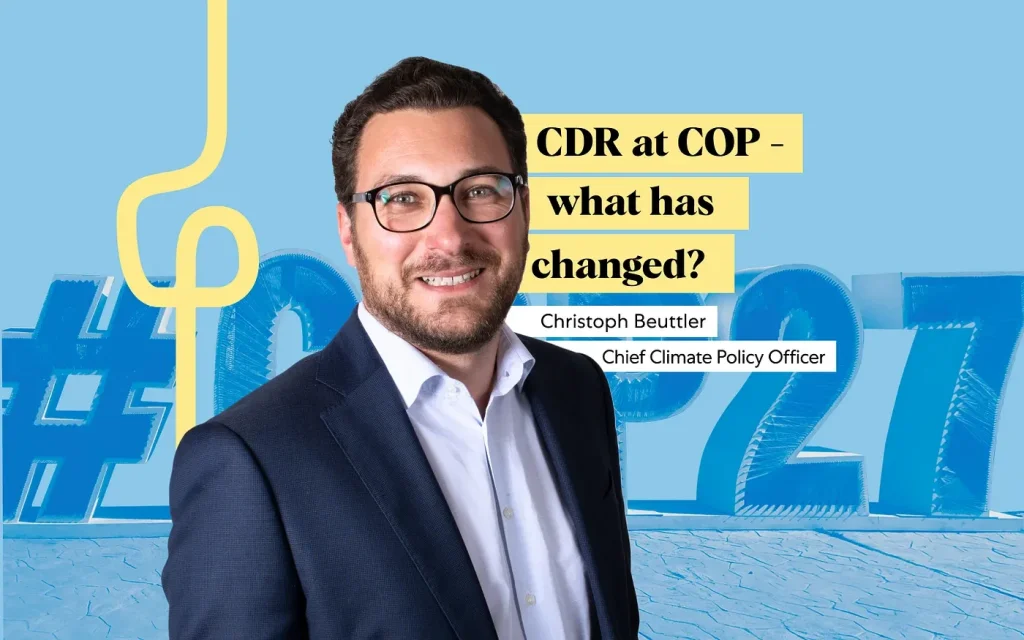
The world has roughly eight years left to cut annual emissions in half. By 2050, we'll need to reduce our global CO₂ emissions to as close to zero as possible and remove all remaining CO₂ emissions from the atmosphere (3–12 gigatons, according to the IPCC). Once at net-zero CO₂, the IPCC stresses the ongoing need to have an overall net-negative CO₂ emissions balance each and every year.
The path toward these targets is probably the most significant challenge humanity has ever faced, but there are a number of solutions available today to help achieve it, including carbon dioxide removal (CDR). In fact, after COP27, we can confidently say that CDR is now a firm part of climate policy and action at the UN level. There is a massive amount of interest and more appetite for investments and support than ever before.
At the moment, however, high-quality solutions that are permanent, additional, measurable, and scalable are scarce. Long-term demand must increase even more to enable the scale-up to the required gigaton capacities. In parallel, we need to drive integrity by establishing standards for the measurement, reporting, and verification (MRV) of CDR.
The launch of the world’s first full-chain certification methodology for CDR via direct air capture and storage (DAC+S) by Climeworks and Carbfix, which was validated by DNV, represents a crucial step towards more transparency and accountability. What’s needed now is that such individual efforts, though powerful, are matched with a comprehensive framework at an international level.
Even if the outcomes of COP27 on the main theme of adaptation were not as concrete as they could have been, it’s worth highlighting some of the progress that has been made on this front toward high-integrity rules, especially concerning demand and use.

Increased scrutiny of net-zero claims
The widespread adoption of unified net-zero language is crucial to building a common understanding and defining the way forward for effective climate action. Both the UN high-level expert group on net-zero commitments of non-state entities and the ISO Net Zero Guidelines that were officially launched in Sharm el-Sheikh provide meaningful guidance in the fragmented net-zero landscape. The emphasis that they put on the complementary role of CDR and emissions reductions is particularly important, as we firmly believe that we need separate — and equally stringent — frameworks for both mitigation measures.
More room to breathe for Article 6
Ahead of COP27, there has been a fair share of intense discussions around the CDR recommendations of the UN Supervisory Body of Article 6.4. We welcome the growing importance that CDR has gained within these negotiations, noting that CDR activities still come as a novelty. The Paris Agreement is yet unresolved in some aspects, which — amongst other things — is perhaps best reflected in the decision to postpone the final decisions on a UN-governed carbon market for another year.
The failure to adopt either the recommendations for CDR or the new “Paris Markets” should not be understood as a loss for CDR but rather as a win for the Supervisory Body and negotiators to continue their work on the CDR framework under Article 6.4. The increasing attention that is being paid to CDR under the Paris Agreement is important and will no doubt increase over the coming years, but this should not come at the expense of well-considered, science-based guidance.
“The failure to adopt the recommendations on CDR by CMA 4 should not be understood as a loss, but rather as a win for the Supervisory Body to continue and strengthen their work on the CDR framework under Article 6.4.”
The ink has dried on the first-ever ITMO emission tradings
Under Article 6.2 of the Paris Agreement, countries can purchase or trade carbon credits from other countries as Internationally Transferred Mitigation Outcomes (ITMOs). Ghana, Switzerland, and Vanuatu have now approved the first-ever voluntary ITMO transactions with which Switzerland will reduce its greenhouse gas emissions. This pioneering example demonstrates how individual states can take concrete climate action, despite the lack of final recommendations in the UN-wide negotiations. We welcome many more countries to pilot the Paris framework to gather learnings to be shared far and wide. Bilateral cooperation can be a door opener for multilateral cooperation.
Through the impressive work that’s being done by state actors, intragovernmental bodies, voluntary accounting initiatives, and the academic world, we are slowly moving closer toward a comprehensive policy framework for CDR. It’s still in its infancy, but alongside continued voluntary action by pioneering businesses, CDR will be able to fulfill its potential to help limit global warming to 1.5°C. The increased diversity and continued dedication of the CDR community at this year’s COP, from CDR providers and civil society observers to representatives and delegates from around the globe, is a hopeful signal for the willingness to “get removals right.”
Interested to learn more?
Learn how to assess the quality of carbon removal solutions in: Transparency in the carbon removal market.
Discover underground carbon dioxide storage by reading: What is underground mineralization of CO₂?
Check out our insights on: How carbon removal solutions fight climate change.
Lead the race toward net zero
High-quality carbon removal for your climate strategy.
